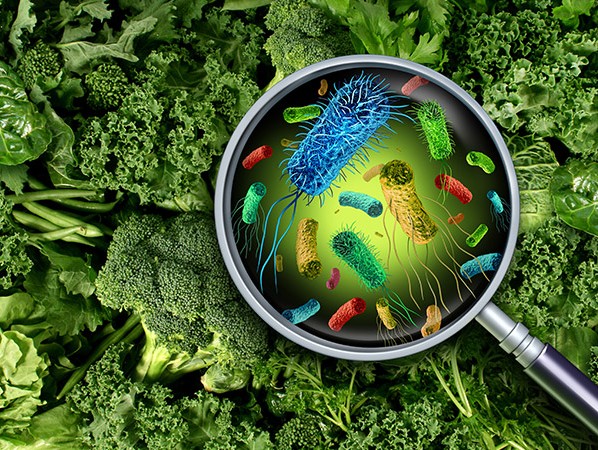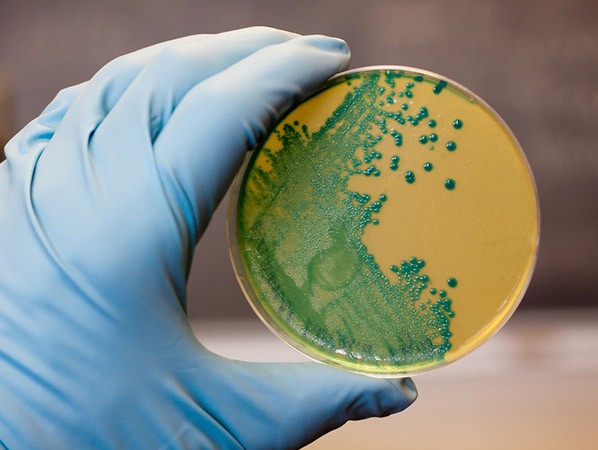
Products are increasingly being recalled from the market due to a Listeria contamination. Data from the National Institute for Public Health and Environment (RIVM) shows that the number of cases of listeriosis is also increasing in the Netherlands. What are the underlying causes? And how do you arrange your production and storage so that Listeria doesn’t become a problem?
Listeria monocytogenes causes listeriosis. L. monocytogenes is a ubiquitous bacteria that can be encountered everywhere in the environment and is able to survive in adverse conditions, such as drought or low temperatures. It cannot multiply in drought, but it can multiply at low temperatures. The greatest risk of infection is with unborn children, because infection can lead to miscarriage or premature birth. But listeriosis can also be very dangerous to young children, the elderly, immunocompromised people and consumers who take stomach acid inhibitors.
L. monocytogenes can survive and grow under aerobic conditions, but also under anaerobic conditions in the presence of fermentable carbohydrates. Growth occurs between 0°C and 45 °C, with optimal conditions between 30 and 37 °C. L. monocytogenes is relatively heat resistant. This is reported extensively in the literature: survival temperatures ranging from a few minutes at 65 °C to several seconds at 80 °C are mentioned. After extensive research in 1989, however, it was found that 2 minutes of heating at 70 °C at the core of the product is sufficient to inactivate L. monocytogenes.
The minimum pH for growth is around 4.4. At lower pH, multiplication doesn’t take place anymore. L. monocytogenes can still multiply at an aw value of approximately 0.92 and survives at salt levels up to 20%. This also means that L. monocytogenes can survive for a very long time in dry products with aw values below 0.90. The bacteria can form biofilms in which L. monocytogenes is more robust than as single bacteria on a surface or in suspension.
Listeria is most commonly found in food products of animal origin, but vegetable products can also be contaminated. Risk products are products that are stored cold for a long time and are eaten without being prepared by heating. Smoked fish, soft mould cheeses and cooked and/or sliced meats are mainly associated with Listeria. But other meats, chilled pate, hot dogs, chilled sandwiches and chilled ready-to eat dishes such as raw vegetable salads and meals are a risk as well.
The European regulations that are enforced by the Netherlands Food and Consumer Product Safety Authority (NVWA) stipulate that the number of L. monocytogenes colony-forming units (cfu) must be below 100 per gram of ready-made product if it is a product in which Listeria can’t multiply. For products in which Listeria can multiply, Listeria must be demonstrably absent after production in 5 samples of 25 grams or it must be shown that the number remains below 100 per gram during the entire shelf life period. With this upper limit as a starting point, it is important to take steps in order to minimise the spread of the bacteria. Essential are: good product/input material (ingredients) and strict process hygiene (including effective cleaning to avoid cross-contamination). Where possible, kill the bacteria or inhibit its growth. Just like other micro-organisms, Listeria can be killed by sufficiently heating the products. But the latter is a major challenge for many companies, because heating is not always possible.
In that case, it is important to affect the conditions in or around the product in such a way that growth is strongly limited or even becomes impossible. Think of measures like lowering the pH to <4.4. This way, the product does not longer support growth of L. monocytogenes. Another option is to keep the storage temperature as low as possible, which inhibits growth.

Based on the determined growth rate, it is possible to determine the shelf life. Finally, according to Leistner’s hurdle theory, additives can be added to the product that act as multiple hurdles. Think of lactate, diacetate, bacteriocins, Lauroyl-L-arginine ethyl ester (LAE), and plant extracts with an anti-microbiological properties.
In order to assure food safety, producers must be able to substantiate the shelf life period of products with regard to L. monocytogenes. For a substantiation of the shelf life of a ready-to-eat product, we distinguish between two types of products: products that are unable to support the growth of L. monocytogenes, meaning the bacteria cannot grow, and products that are able to support the growth of the organism. For both types of products, the objective is to limit Listeria contamination as much as possible before and after production. For products in which multiplication is possible, the criterion is absence in 5 samples of 25 gram (<0.04 kve/g). If it is substantiated that multiplication is not possible, this value can be deviated from. Generally speaking, for the substantiation to predict the growth of Listeria, it is necessary to combine different perspectives: use both scientific literature and growth models.
A first indication about the growth potential of Listeria can be obtained using predictive growth models. The models need to be validated with additional challenge tests, in which you test whether the limit of <100 kve/g is actually achieved during the entire shelf life period. In addition, information from historical data of analytical results provide specific substantiation. Historical data is also necessary for performing trend analyses in order to identify unwanted developments in production, to be able to intervene in time.
Listeria monocytogenes is a serious danger, especially for chilled fresh ready-to-eat products that undergo no further heat treatment before consumption. Good hygiene with a substantiated assurance and control of the entire production process, including shelf life, is essential for controlling the risk of L. monocytogenes infection via the product.
Source: © Vakblad Voedingsindustrie 2019